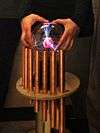Cycleonium
"The cycleonium is a computer based music instrument. Every day objects like a bicycle and a bottle, and also a propeller are put in a new context and form the base of the sound design. They lose their conventional function consequently and have to be considered as indispensable parameters of this instrument."[1] It was developed by Daniel Dominguez Teruel from 2007–2009 and built with the support of Chiron-Werke GmbH & Co. KG.

The physical and mechanical work that is required to make this sound-machine sound basically doesn’t differ from traditional musical instruments. For instance, a guitar: it sounds, respectively do we perceive it acoustically, if the strings are excited or the corpus is oscillated somehow or other. So the player expends energy and translates it into the instrument. The user and viewer of the cycleonium is to be made aware of that, in principle, musical instruments are nothing else than objects that only operate with a certain energy expenditure. The energy flow that is emerged thereby plays here a primary role. Therefore we use the word fluxus, but more in a semantically significance (lat. flux, fluidum = flow) than artistic aesthetics. Any kind of sounds require energy to sound. They have self-energy indeed, but it first has to be excited. Otherwise every sound is only a sounding abstraction (they aren’t a perpetual motion machine) that we don't hear. The player of the cycleonium produces, amongst others, kinetic energy that excites a propeller that simultaneously blows air on the aperture of a bottle: a pitched sound is audible.
Description

"The cycleonium consists basically of four pieces: a bicycle (...), a bottle and a propeller that form the hardware and a computer for software-based sound processing (live-electronics). The bicycle is rebuilt in such a way that it resembles a stationary bicycle. In this way the propeller can be powered whereby the emerging air flow hits the angle of the aperture of the bottle. Likewise in a flute, a periodical oscillating air column that is perceivable as a tone pitch is produced in the corpus of the bottle [...]. The intensity of the sound depends on the speed of the propeller and consequently on the expended force of the player....The breath of the player and the sound of the chain and arbor of the bicycle are as equally important as the sound of the bottle itself. The produced sounds are amplified and real-time processed. The live-electronics take place in Max/Msp [...] on a Laptop. The sounds can be pitched, transposed, filtered, recorded and played and processed with delay or reverb. Each Parameter can be controlled with a MIDI-controller. The following microphones are used:
- bottle: electret microphone
- breath: dynamic microphone
- chain/arbor: condenser microphone (cardioid)
For instance, over the keynote of the bottle can be formed an overtone scale with 15 partials or more that are controllable individually. The spatialization is realized with delays, which can be filtered, pitched and assigned to the respective audio-outputs discretely in real-time [...]. To bring the bottle in the best possible position to the airflow one can adjust it in height, distance and angle to the propeller."[1]
Purpose
"The player perches on it like on a stationary bicycle and starts to pedal. The midi-controller and the Laptop can be put on a tray that is at the height of the handlebar. By using a dynamic microphone that is at the height of the mouth he can experiment with his [sic] voice respectively breath and modify it per MIDI in real-time. The sound of the arbor at the propeller and the chain is recorded with a condenser microphone (cardioid). Through reverse turns of the pedals the sound of chain and arbor becomes more concisely and is at the same time a variation of sound. By alternating forward and reverse turns a percussive rhythmical complement is built to the laminary sound of the bottle that mainly can be modified in the pitch. Dense and complex structures of sound can be achieved by adding overtones, glissandi and delays."[1]
From the work with the cycleonium Daniel Dominguez Teruel developed the piece 5 Klangaktionen that was nominated for the competition for electroacoustic music IMEB Bourges 2009. Also in 2009 the cycleonium was presented at the 6th Sound and Music Computing Conference in Porto and the ton:art in Karlsruhe.
Sources
- 1 2 3 "New Tendencies in the Digital Music Instrument Design: Progress Report", p.273-74. smc2009.smcnetwork.org.
External links
- "Cycleonium", Ton-Art-Expo.de. (German)
- "Projektlupe│Digitale Klangkunst auf der ton:art Ausstellung 2009", Kavantgar.de. (German)
- "Johannes G. LeBong | Notizen", Lebong.de. (German)
- "Dings Detail: ton:art", Jungerkulturkanal.de. (German)
- "Video Demo", youtube.com. (German)
- "Dominguez describing the cycleonium", "youtube.com". (German)
